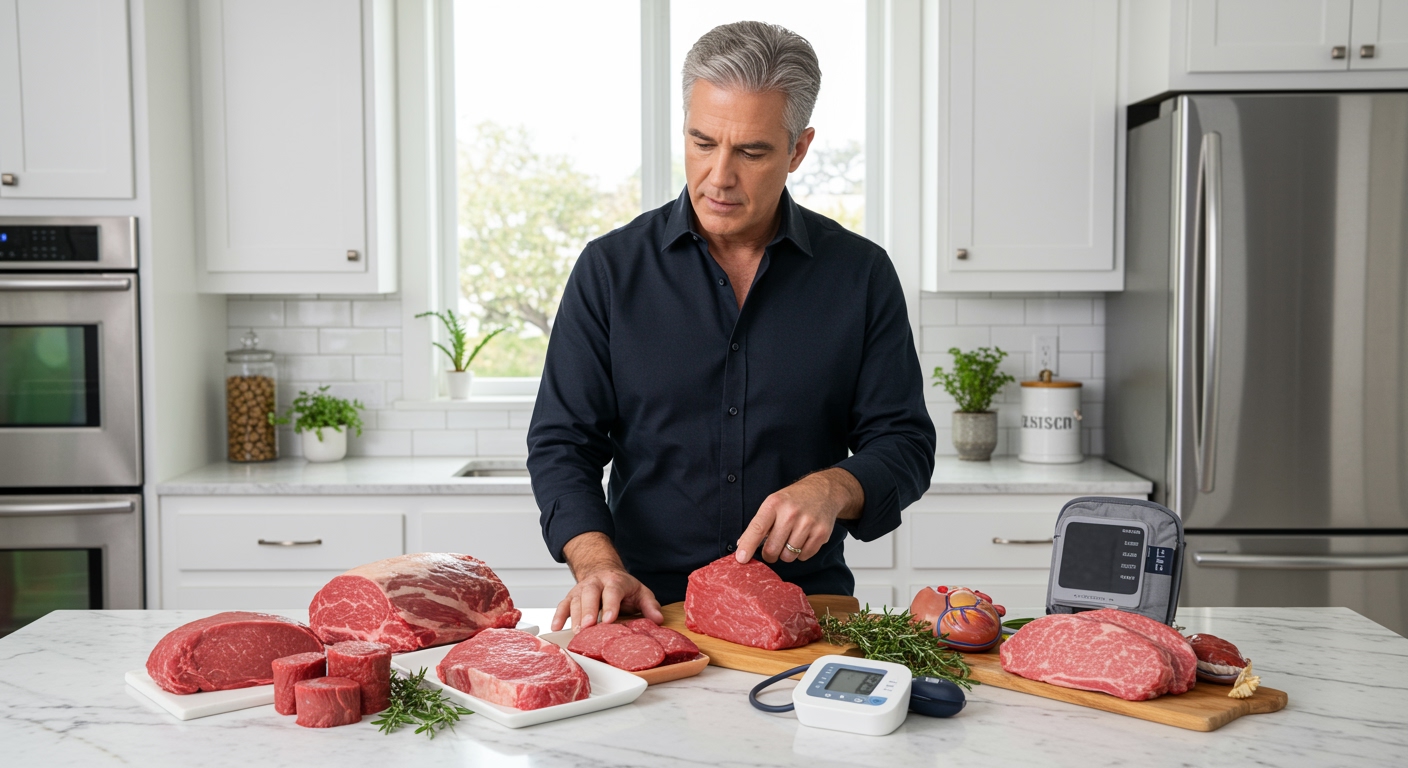✪ Key Takeaway: Red meat itself does not directly cause high blood pressure, but processed varieties and cooking methods can increase your risk.
Introduction
Your doctor just told you to watch your blood pressure, and now you are staring at that juicy steak wondering if it will send your numbers through the roof.
You might be asking this question because conflicting information floods the internet about red meat and heart health, leaving you confused about what to eat and what to avoid.
Hi, I am Abdur, your nutrition coach, and today I am going to explain exactly how red meat affects your blood pressure and show you the smart way to include it in your diet.
What Does Research Actually Say About Red Meat?
The relationship between red meat and blood pressure is more complex than most people realize.
Recent studies show that unprocessed red meat does not significantly raise blood pressure when consumed in moderate amounts as part of a balanced diet.
A 2023 comprehensive review published in the Journal of Hypertension found that people who ate lean red meat three times per week showed no meaningful increase in systolic or diastolic blood pressure compared to those who avoided it completely.
The key difference lies in the processing and preparation methods used.
Fresh cuts of beef, lamb, and pork contain natural proteins and minerals that your body needs, including iron, zinc, and B vitamins that support healthy blood flow.
However, when meat gets processed into sausages, bacon, or deli meats, manufacturers add sodium and preservatives that can elevate blood pressure over time.
✪ Fact: One serving of processed meat contains up to 600mg of sodium, while fresh red meat has only 50-80mg naturally.
Which Types of Red Meat Should You Avoid?
Not all red meat poses the same risk to your cardiovascular system.
Processed meats represent the biggest threat to healthy blood pressure levels because they undergo chemical treatments that alter their nutritional profile.
Bacon, sausages, hot dogs, and deli meats contain high amounts of sodium nitrates and sodium chloride that force your kidneys to retain more water, increasing blood volume and pressure.
These preservatives also trigger inflammation in your blood vessels, making them less flexible and more resistant to blood flow.
Charred or heavily grilled red meat creates compounds called advanced glycation end products that damage the inner lining of your arteries.
High-fat cuts like ribeye, T-bone, and ground beef with more than 20% fat content can contribute to plaque buildup in arteries when eaten frequently.
✪ Pro Tip: Read ingredient labels carefully because many seemingly healthy meat products contain hidden sodium and preservatives.
How Much Red Meat Is Safe for Blood Pressure?
The amount and frequency of red meat consumption matters more than complete avoidance.
Health experts recommend limiting unprocessed red meat to no more than 3-4 servings per week, with each serving being about 3-4 ounces or roughly the size of your palm.
This portion size provides adequate protein and nutrients without overwhelming your cardiovascular system with saturated fat and calories.
For people with existing high blood pressure, reducing red meat to 2-3 servings per week while focusing on lean cuts shows better results for blood pressure control.
The DASH diet, specifically designed for blood pressure management, allows moderate amounts of lean red meat while emphasizing fruits, vegetables, and whole grains.
Your individual response to red meat depends on factors like genetics, overall diet quality, exercise habits, and stress levels.
Some people can handle more red meat without blood pressure changes, while others need to be more restrictive to see improvements.
✪ Note: Track your blood pressure readings for two weeks after changing your red meat intake to see your personal response.
What Are the Best Red Meat Choices for Heart Health?
Choosing the right cuts and preparation methods can make red meat part of a heart-healthy diet.
Lean cuts like eye of round, bottom round, sirloin tip, and tenderloin contain less saturated fat and fewer calories per serving.
Grass-fed beef provides higher levels of omega-3 fatty acids and antioxidants compared to grain-fed varieties, which can help reduce inflammation in blood vessels.
Cooking methods significantly impact how red meat affects your blood pressure.
Grilling, broiling, or roasting at moderate temperatures preserves nutrients while avoiding the formation of harmful compounds that damage arteries.
Marinating meat in herbs and spices like garlic, rosemary, and turmeric adds antioxidants that protect against oxidative stress during cooking.
Pairing red meat with potassium-rich vegetables like spinach, broccoli, or sweet potatoes helps balance sodium levels and supports healthy blood pressure.
✪ Pro Tip: Trim visible fat before cooking and drain excess grease to reduce saturated fat content by up to 30%.
The Bottom Line
Red meat does not automatically raise your blood pressure when you choose lean cuts, control portions, and avoid processed varieties.
Smart choices beat complete restriction every time because sustainable eating habits produce better long-term health outcomes than extreme dietary changes you cannot maintain.
I would love to hear about your experiences with red meat and blood pressure in the comments below, so please share your questions, concerns, or success stories to help others on their health journey.
References
At NutritionCrown, we use quality and credible sources to ensure our content is accurate and trustworthy. Below are the sources referenced in creating this article:





